TypeCon2017: Counter! was filled with female faces this year, and I thought that Alphabettes readers would be glad to see some of them.

Faces of 16 of the 35 female presenters at TypeCon2017: Counter! – (top left to bottom right)
Andrea Leksen, Petra Dočekalová, Catherine Leigh Schmidt, Linh O’Briant, Aoife Mooney and Jillian Coorey, Ming Wei, Geri McCormick, Reneé Seward, Elizabeth Carey Smith, Ana Monroe, Frances MacLeod, Amelia Hugill-Fontanel, Rachel Elnar, Charlotte Yue Qin, and Ina Saltz.
In our most accurate count, 48.6% of our presenters were female this year – this includes workshop leaders and speakers in the main program and education forum. You can read more about our 2017 speakers and programming on our website.
Our speakers are chosen via a blind selection process – meaning that the speaker’s name, gender, company, product name, or any other identifying information is removed from their proposal before it is read and ranked by a panel of reviewers. We’ve taken this approach in an attempt to reduce bias and to level the playing field for everyone submitting.

